My go-to tent while backpacking is freestanding, which means if my tent stakes can’t find purchase in the ground, then I don’t have a tent. Over the years, I’ve been caught in a number of situations where my stakes failed for a whole slew of reasons: a sudden intense rainstorm turned the ground to mush, intense winds popped the stakes right out of the ground, and hard-as-concrete dirt roads. To help ensure your tent stays up no matter the conditions, I put nineteen of the best tent stakes through a series of tests to find out which had the holding power and durability to withstand the elements.
- Best Overall: MSR Groundhog
- Best Lightweight: MSR Carbon Core
- Best Holding Power: Big Agnes Dirt Dagger UL
- Best for Neat Freaks: NEMO Sweepstake
- Best Shepherd’s Hook: TOAKS Hook Peg
- Best for DIY Tents: NEMO Airpin
- Best for Car Camping: Decathlon Quechua Hard Ground
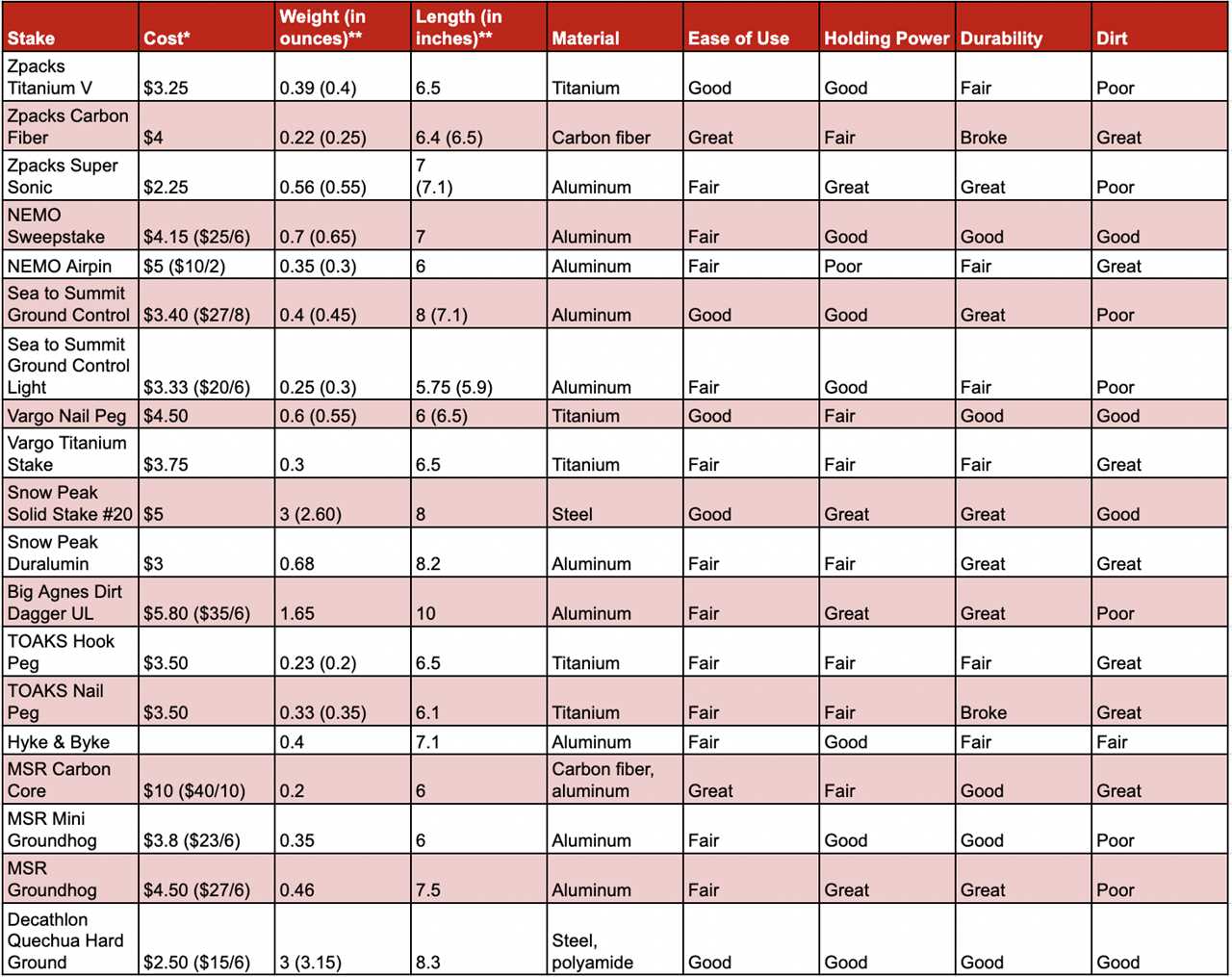
*Prices are provided for individual stakes; however, instances where stakes are only sold in bulk are noted in a parenthetical
**Measurements provided are based on manufacturer specifications; instances where I measured a different weight or length are noted in the parenthetical
How I Tested Tent Stakes
Weight
The first step in testing was to check both weight and length against the manufacturer-provided specifications out of the box. Generally, these matched what the manufacturer provided, although minor discrepancies were noted in the above table.
Holding Power and Ideal Ground
Tent stakes were then tested in tandem at four separate test sites. The first one was on what could be considered ideal ground for pitching a tent—firm enough that a tool (in this case, the MSR Stake Hammer) was useful for pushing the tent stake into the ground, but not so firm as to be arduous. One stake broke at this stage, the TOAKS Nail Peg, and was removed from further testing.
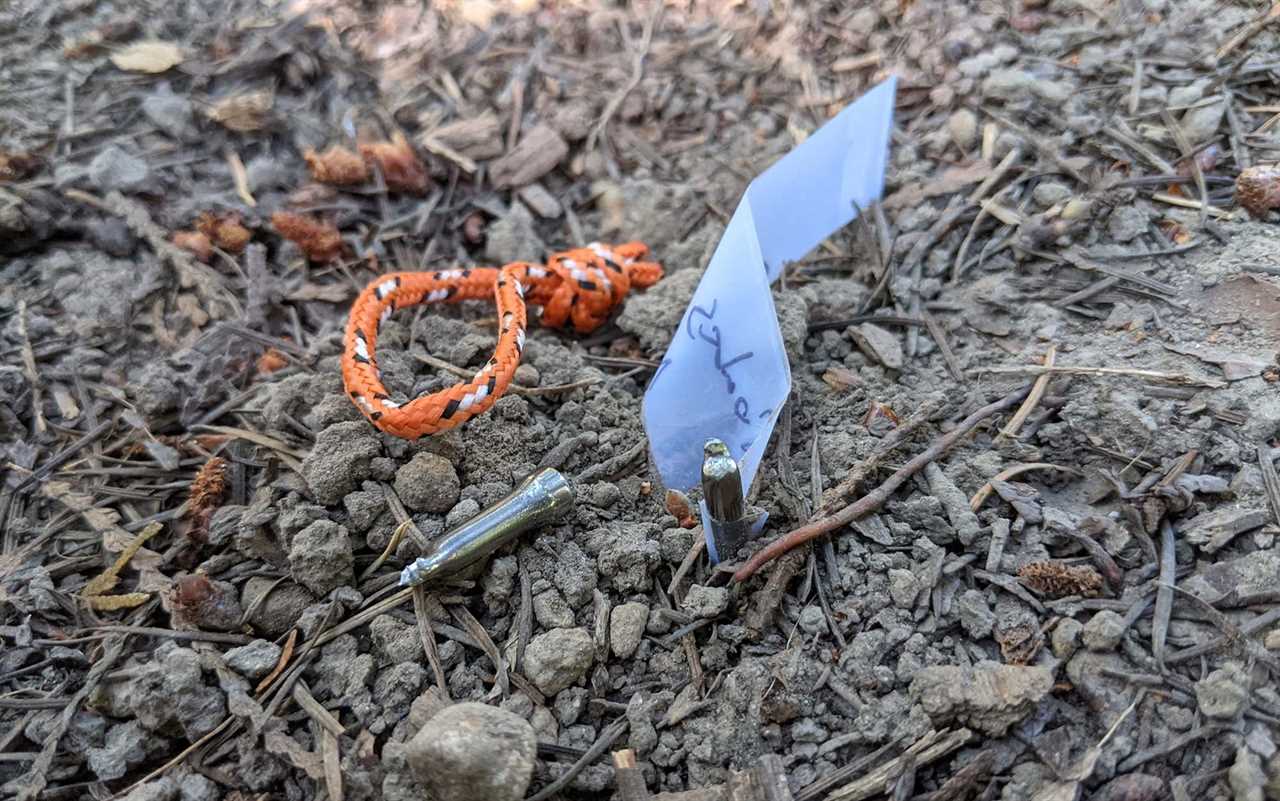
Pulling up a broken tent stake without a pull loop took longer than I expected. Laura Lancaster
During this first stage of testing, I also checked the holding power of each stake by securing a guyline to it and pulling it in several different directions. It should be noted that while I tried to find similarly firm ground for each stake I looked at, there are inevitable differences—rocks, roots, soil density—that can and do occur during testing.
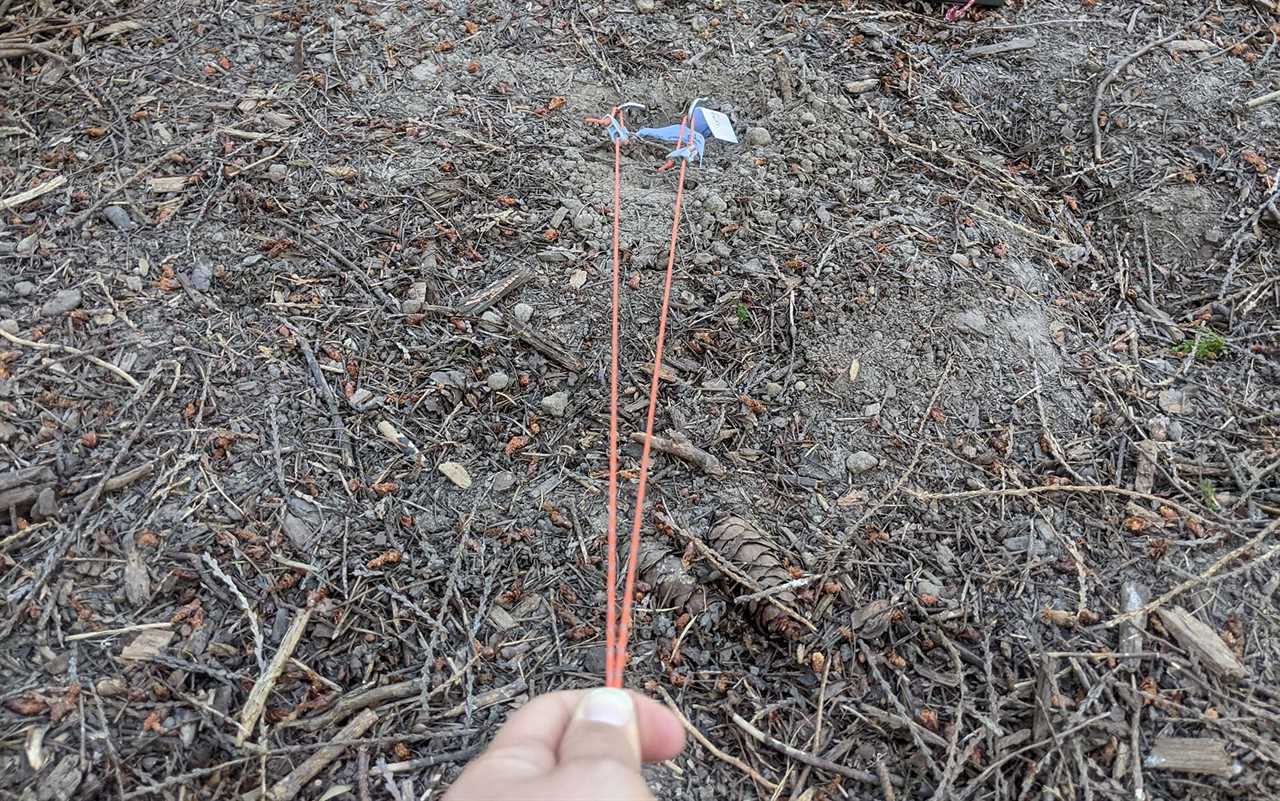
Pulling on two shepherd’s hook stakes during the first stage of testing. Laura Lancaster
Soft Ground
The next test was conducted on soft ground, where the top layer of forest floor debris makes it especially difficult to secure stakes. Here I checked the holding power of each stake and looked at how much dirt or other debris the stakes were holding onto and how difficult they were to clean off afterward. After that, I switched to the more notorious hard ground, most commonly seen in heavily used camping areas, including those where cars or RVs may have run over the exact spot you want to stake your tent in.
Hard Ground
For the hard ground site, I used both a rock and the Snow Peak Steel Head Peg Hammer to push the stakes into the ground. During this stage, I looked at how easy each tent stake was to use, and how easy it was to take out again, checking for durability issues (either dents, chips, or bends).
Durability (Boot Test)
After the hard ground test, I put each tent stake through a durability, or “boot test,” placing the stakes at a forty-five degree angle and then stepping down (not stomping) on them with my foot. Stakes that bent during this stage were noted. The final test was a return to the ideal ground for testing to see if the boot test had impacted performance.
Best Overall: MSR Groundhog
Why It Made the Cut
It was a tight race for the best tent stake, but in the end, the lightweight MSR Groundhog had superior holding power to the Sea to Summit Ground Control and a lower weight than the Zpacks Super Sonic.
Key Features
- Weight: 0.46 ounces
- Style: Y-beam
- Material: Aluminum
- Length: 7.5 inches
Pros
- Great holding power
- Low weight
- Durable
Cons
- Uncomfortable to push into the ground
Product Description
This one was close. It was so close, in fact, that I added on a few additional testing protocols after I’d finished with the rest of the stakes just to try to separate out the Zpacks Super Sonic from the MSR Groundhog from the Sea to Summit Ground Control. All three had excellent holding power—the most important criteria during testing—at a low weight. All three held onto tons of dirt that had to be scraped off by hand after each test (annoying), and all three were kind of uncomfortable to use (the trade off for that effective Y-beam design). But their superior holding power kept them in the top slot, so I kept testing. I pushed them into sand. I threw them in the freezer overnight and then right into a pot of boiling water. I ran over them with my car. None of the stakes showed any signs of noticing. All three are great stakes.
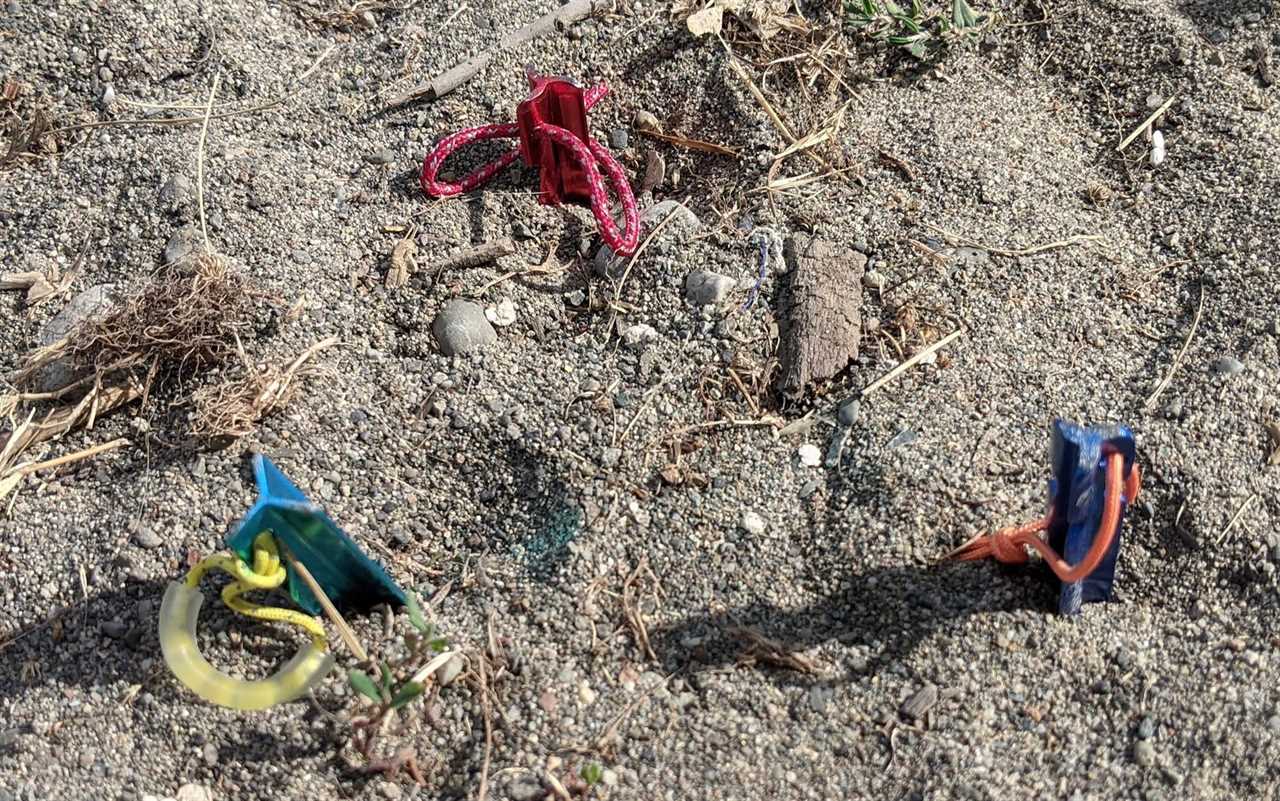
Even in sand, the three finalists had great holding power. Laura Lancaster
So then it comes down to the smallest of details. While I liked some of the Sea to Summit Ground Control’s features, including the three different heights for securing your cord or guyline, and a pull tab that was noticeably more comfortable to use than a simple nylon cord, it was ever-so-slightly less effective in loose soil. The wavier top-down profile of the Zpacks Super Sonic and MSR Groundhog held better than the straight lines of the Sea to Summit Ground Control.
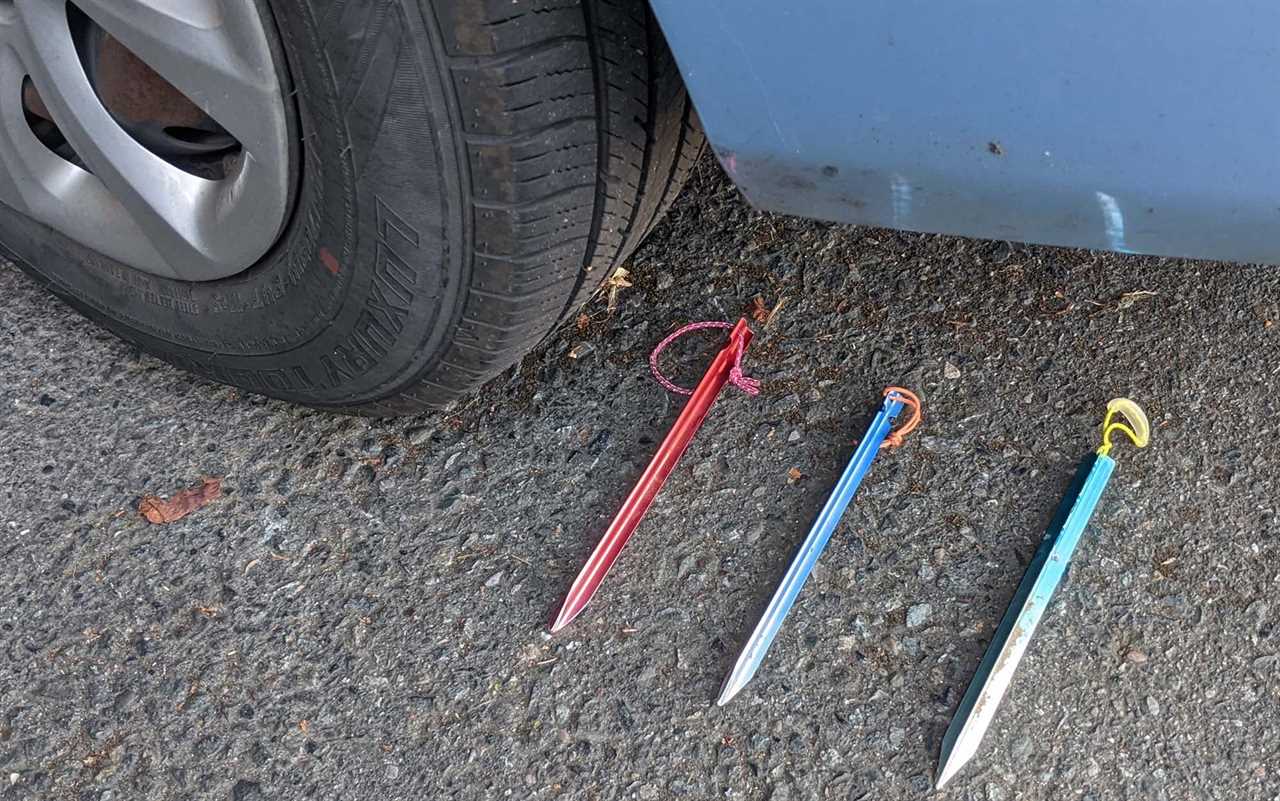
This could just as easily have been the after shot as the before shot. Laura Lancaster
While the slightly stockier Zpacks Super Sonic performed at the same level during testing as the MSR Groundhog, I measured it at 0.09 ounces, or 2.5 grams, heavier. So the MSR Groundhog it is.
I should note that, while holding power was more highly prioritized than ease of use or dirt during testing, a Y-beam stake that was actually comfortable to push into the ground would improve the user experience and likely win the best overall slot (assuming durability wasn’t compromised in the process).
Best Lightweight: MSR Carbon Core
Why It Made the Cut
The MSR Carbon Core was not only the lightest tent stake in my test, but it was also comfortable to use and surprisingly durable.
Key Features
- Weight: 0.2 ounces
- Style: Cylindrical
- Material: Carbon fiber, aluminum
- Length: 6 inches
Pros
- Extremely lightweight
- Comfortable to use
Cons
- The most expensive stake I tested
- On the shorter side
Product Description
Anyone who has ever used a piece of gear that incorporates carbon fiber knows how delicate it is. It’s light as a feather and strong as nails when handled with kid gloves, but if you don’t treat it just so, it has a tendency to splinter. In soft ground, it’s easy enough to go easy on a stake, but on hard ground, where it takes some real force to get the stake into and out of the ground, things can go sideways. During testing, one of two stakes that incorporated carbon fiber splintered when I removed the stake from the ground during the firm ground phase.
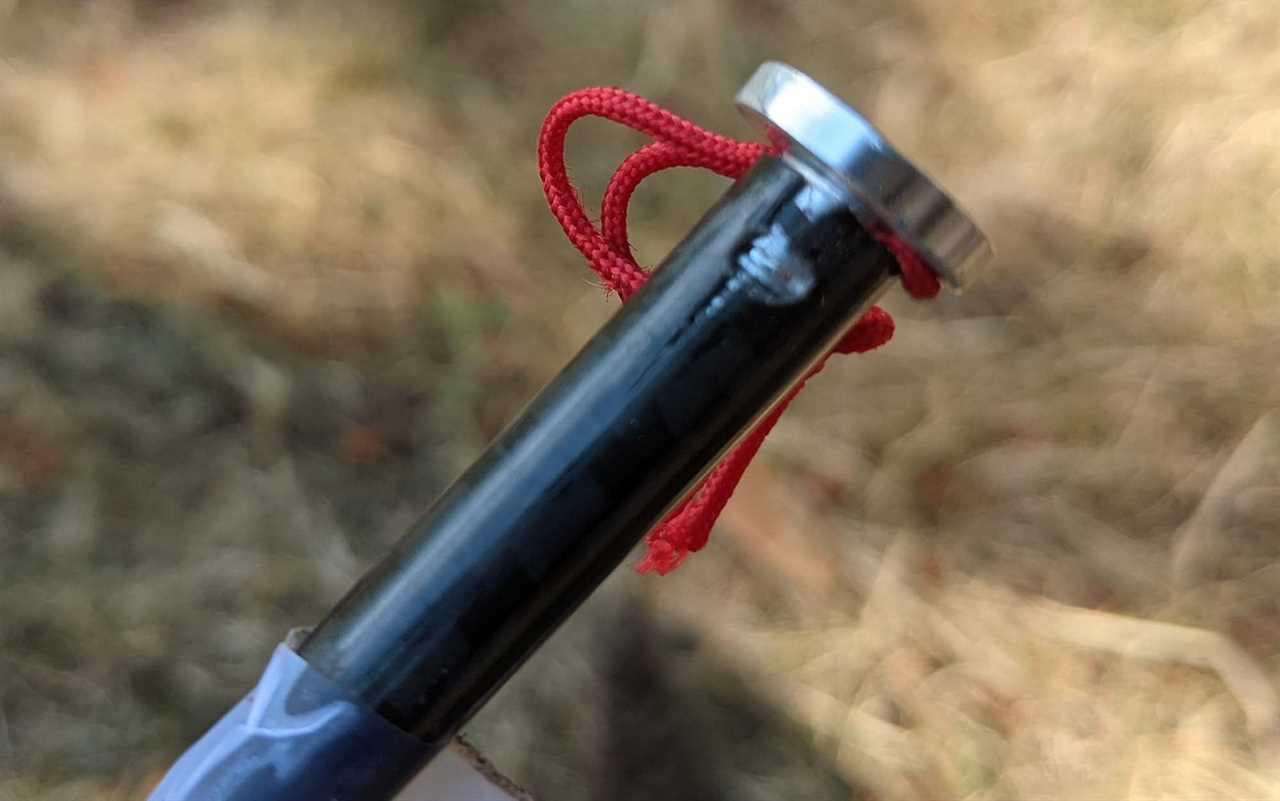
The Zpacks Carbon Fiber stake splintered when it was removed from the soil during the hard ground test. Laura Lancaster
Not so with the MSR Carbon Core, due to one important design detail: The carbon fiber is on the inside of the stake, where it can provide the rigidity you need in challenging soil environments, with an aluminum layer wrapped around it for protection. During testing, I was able to both hammer it into hard ground and remove it again without issue, with the only signs of wear being some light scuffing on the plastic of the head of the stake and some color loss on the tip.
Like all stakes with a classical cylindrical design, these were not as effective at holding in soft soil as those with a V-beam or Y-beam design. Carbon Cores are also by far the most expensive stakes I tested, about twice the cost of the next most expensive model in the best tent stakes test. But if you are looking to cut grams and are willing to be a bit more careful with your gear to get there, then these are an excellent choice.
Best Holding Power: Big Agnes Dirt Dagger UL
Why It Made the Cut
If you’ll be camping in the elements on less-than-ideal terrain for pitching a tent, then this is the stake that will keep your tent on the ground in basically any weather.
Key Features
- Weight: 1.65 ounces
- Style: Modified I-beam
- Material: Aluminum
- Length: 10 inches (also available in 7.5 and 6 inches)
Pros
- Great holding power
- Comes in a variety of lengths
- Lightweight for its size
Cons
- More stake than most backpackers need
- Hard to push down with your foot
Product Description
The second thing you notice about the Big Agnes Dirt Dagger UL is its unusual design—if the top stakes in my test tended to be the V-shaped or Y-shaped stakes, this could be described as the serif T-shaped stake. But it was hard to assess if this was in fact the better stake design overall because of the number one reason this stake had such great holding power (and the first thing you notice about it): At ten inches, this was easily the longest tent stake in my test. The Big Agnes Dirt Dagger UL just goes way deeper into the ground, and when it comes to holding power, that’s one of the most important factors there is.
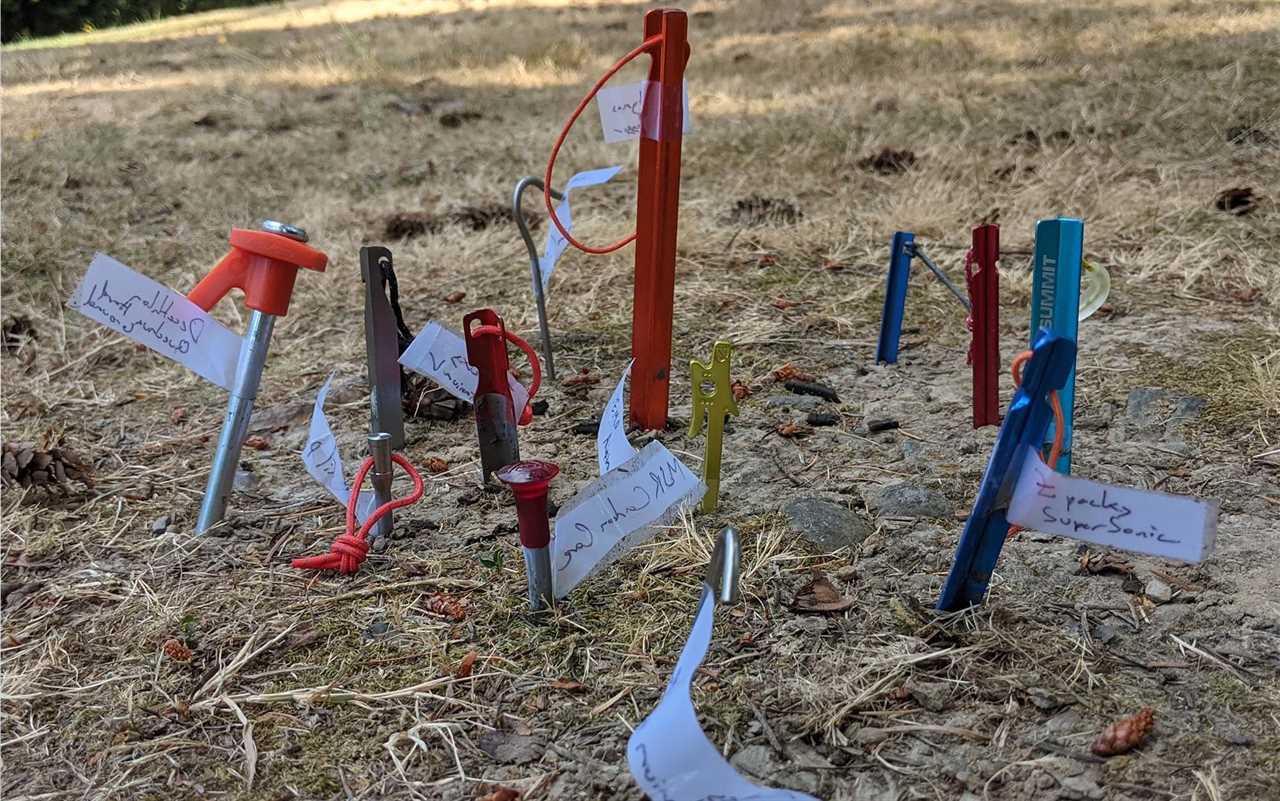
During the hard ground test, the Big Agnes Dirt Dagger UL was Gulliver among the Lilliput. Laura Lancaster
At 1.65 ounces, this stake was both the heaviest of all of the backpacking stakes I looked at, and by far the lightest of the stakes that you might consider for car camping. So while it’s worth keeping a set of these in your gear closet for trips to destinations with thick topsoil or loose sand, they are unlikely to be your go-to choice for the majority of backpacking trips.
Best for Neat Freaks: NEMO Sweepstake
Why It Made the Cut
The NEMO Sweepstake was the only Y-shaped tent stake I tested that wasn’t a chore to clean off before packing away.
Key Features
- Weight: 0.7 ounces (manufacturer provided); 0.65 ounces (as measured)
- Style: Y-beam
- Material: Aluminum
- Length: 7 inches
Pros
- Easy to clean
- Holds well in different soil types
- Durable
Cons
- Uncomfortable to use
- Heavy compared to similar designs
Product Description
I have a friend whose gear I’m a little reluctant to borrow: It’s always just so clean. And while I try (read: try) to be good about airing out my sleeping quilt and hanging up the rain fly and groundsheet of one of the best backpacking tents after each use, I always lose steam when it comes to my stake bag. Stakes, especially those with great holding power like the Y-beam or V-beam designs, just collect so much dirt and grime and getting it off is a chore. It’s easier to just keep them separate from the rest of my gear.
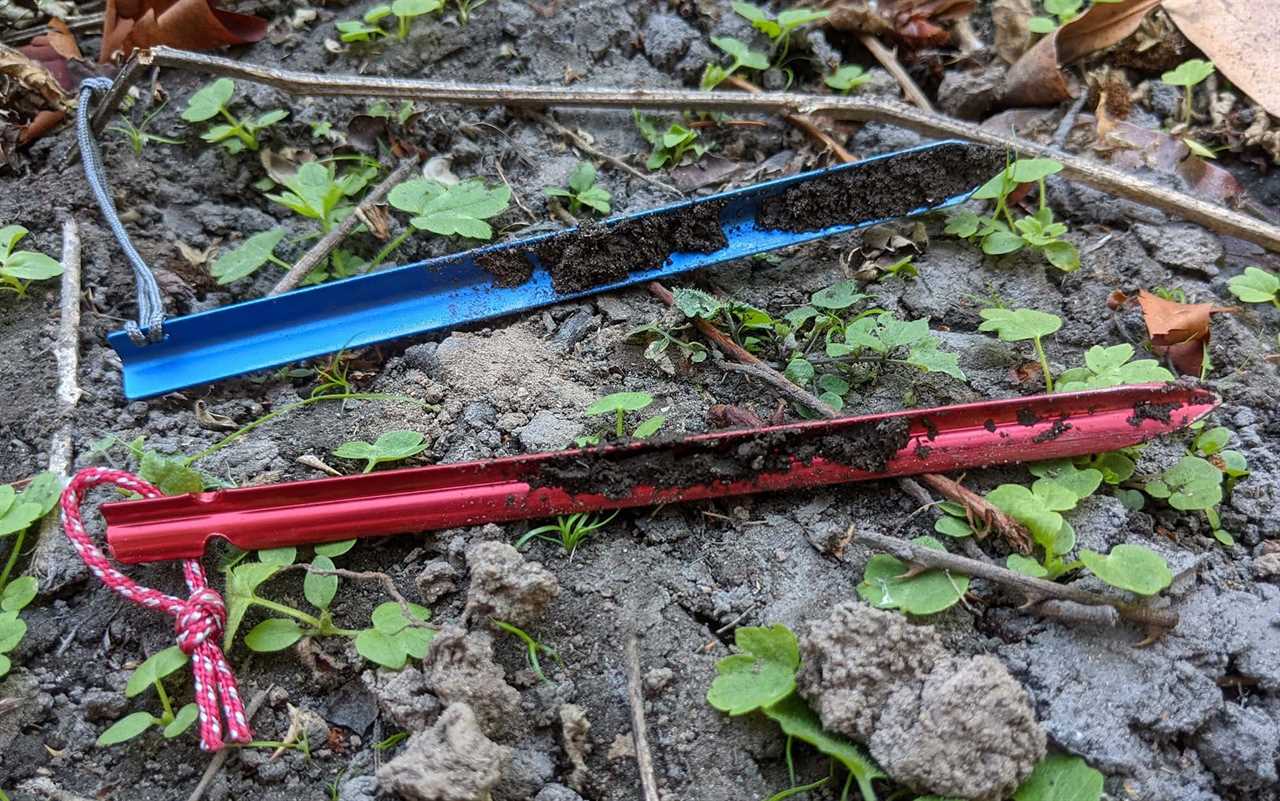
What’s the point of choosing a lightweight Y-shape design if you’re just carry around a couple of ounces of dirt as a result? Laura Lancaster
The NEMO Sweepstake solves for this problem by incorporating a circular piece of plastic, the biscuit, at the top of the stake, connected to the pull tab. When dirt (inevitably) collects along the length of the stake, simply pull the biscuit down and it swipes it away. Voila. As an added bonus, the biscuit glows in the dark, which can be helpful when you are trying to get back to your tent after a midnight bathroom break.
The downside to the NEMO Sweepstake is that this extra feature comes at a cost: extra weight. Albeit only a couple of grams, but it can add up when using six or more on your tent. Also, like all Y-bean designs, it was uncomfortable to push into the ground.
Best Shepherd’s Hook: TOAKS Hook Peg
Why It Made the Cut
The lightest shepherd’s hook may have bent during the boot test, but, since it’s made out of titanium, I was able to just bend it back again.
Key Features
- Weight: 0.23 ounces (manufacturer provided); 0.20 ounces (as measured)
- Style: Shepherd’s hook
- Material: Titanium
- Length: 6.5 inches
Pros
- As light as my best ultralight pick
- Easy to hook tent loops onto
- Simple, classic design
Cons
- Not as strong of holding power as the Y-shape or V-shape designs
- Bent during the boot test
Product Description
So, the TOAKS Hook Peg bent during the boot test. Who cares? It’s made from titanium—and it’s not that thin—just bend it back again and continue with your trip. More importantly, at 0.23 ounces, you could carry eight of these at less than two ounces; you only get three of the significantly thicker (and heavier) Snow Peak Duralimun for that.
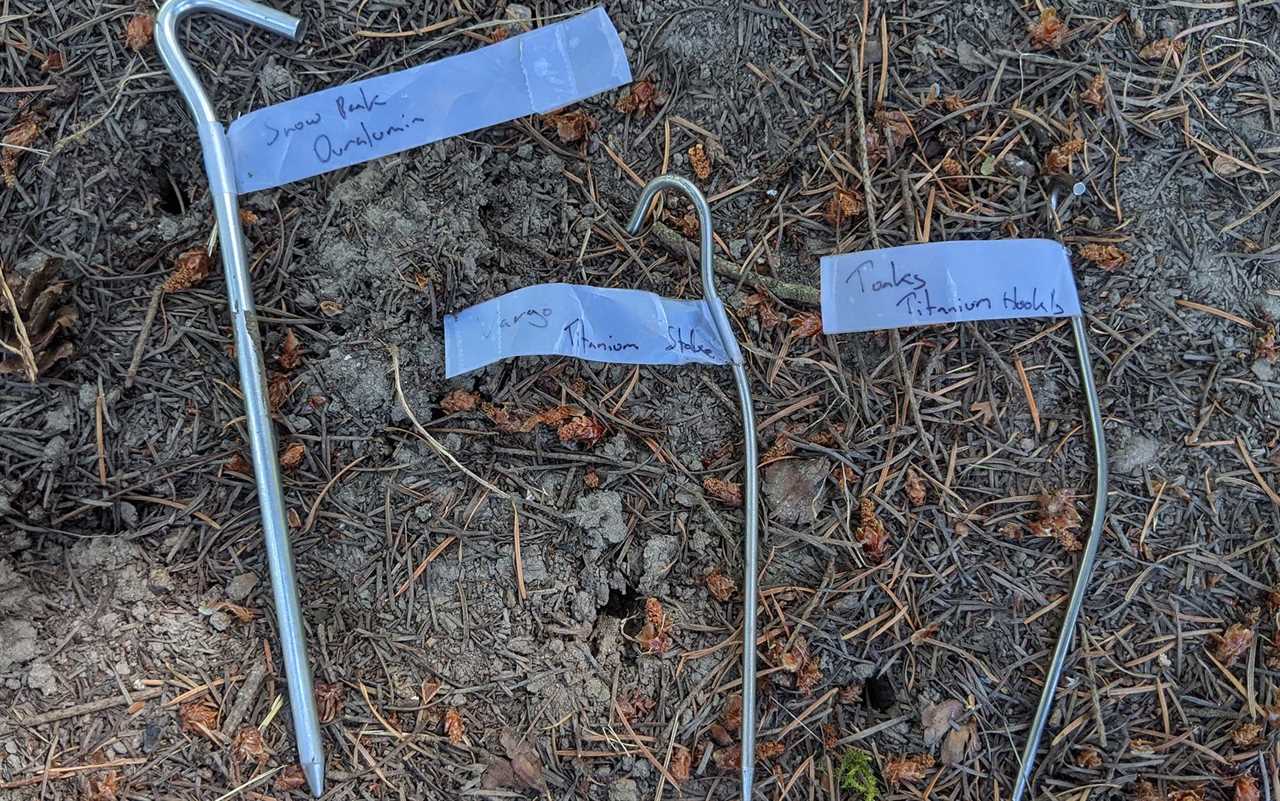
The Toaks Titanium Hook (right) may have bent during testing, but it was easy enough to bend into something resembling its original shape. Laura Lancaster
But do you want a shepherd’s hook style stake? There are some pros and cons. The first pro is that the simplicity of the design means that the titanium versions can get down to an impressively low weight—as low as the weight of my best ultralight pick. They are also easier to snag a tent loop onto than the Y-shape or nail peg designs. Finally, they just look nice: This is the platonic ideal of a tent stake. Now here are the cons: Like all cylindrical stakes, its holding power in soft dirt is only OK. Worse, in my opinion, is that when pounding the shepherd’s hook stakes into firm ground, it can be hard to get purchase with the rock—these stakes have a tendency to just vibrate a whole bunch without actually going into the ground. They will eventually go in, but it can be significantly more time consuming than with a different style stake.
Best for DIY Tents: NEMO Airpin
Why It Made the Cut
The cord locking mechanism of the lightweight NEMO Airpin works great and it was the only tent stake of all the products I tested (or considered for testing) that used this design.
Key Features
- Weight: 0.35 ounces (manufacturer provided); 0.30 ounces (as measured)
- Style: Square-shaped
- Material: Aluminum
- Length: 6 inches
Pros
- Can hold tension without the need for fancy knots or a Lineloc device
- Reasonably lightweight
Cons
- Expensive
- Poor holding power
Product Description
The NEMO Airpin is for backpackers that have been at it for a while and know exactly what their needs are. That’s because, while this stake had some issues during testing, it’s solving for a specific problem that will appeal to those with a more advanced setup.
First off, the biggest problem: The NEMO Airpin had the worst holding power of any stake I looked at. Even in ground that was fairly ideal for staking a tent, the stake wobbled a bit, and in loose soil it moved the most of any in my test. This was the only stake with this specific square profile, and it appears to provide less staying power than a typical cylindrical design, let alone the V-beam or Y-beam stakes. This stake also bent during the boot test, albeit only marginally.
OK, now that we’ve got that out of the way, here’s why you might want to purchase this stake. If your tent or best camping tarp is a more minimal design, or straight-up DIY, then there is a fair chance that the cords and guylines didn’t come with the loop at the end to secure the stake onto. And while you can try tying one yourself, if it comes loose in the field it will be tough to get a secure stake. That’s where the Airpin comes in. By wrapping the cord or guyline around the stake three times (helping dots on the side of the NEMO Airpin help indicate the direction), you easily secure your cord to the stake, no knots required.
Best for Car Camping: Decathlon Quechua Hard Ground
Why It Made the Cut
The low price and steel construction of the Decathlon Quechua Hard Ground made it a clear winner for trips where weight isn’t a factor.
Key Features
- Weight: 3 ounces (manufacturer provided); 3.15 ounces (as measured)
- Style: Cylindrical
- Material: Steel, polyamide
- Length: 8.3 inches
Pros
- Good holding power
- Inexpensive
Cons
Product Description
If you’re car camping with the family, weight isn’t an issue, but you do need to make sure that the stakes you put in the ground will stay there throughout the night. Losing the rainfly while the kids are sleeping just isn’t an option.
During testing, the Snow Peak Solid Stake #20 and Decathlon Quechua Hard Ground were neck-in-neck for best car camping tent stake. They were both made from steel and about eight inches long, providing excellent durability and holding power. They also held onto little dirt given their cylindrical design. But the Decathlon Quechua Hard Ground’s were just a hair longer, and a fair chunk less expensive, so it won my vote for the car camping slot.
While I have some doubts about the plastic pieces at the head of the hammer, which will undergo some stress when the stakes are removed from the ground, the low price of this set means it’s reasonable to purchase a spare set for the tent bag.
Things to Consider Before Buying Tent Stakes
Design
For something as seemingly simple as a tent stake, there is a surprising amount of variety in design. The most common design is a cylindrical tube that ends in a point. This design is used for car camping as well as backpacking tents and has reasonably holding power. Another common design for a stake is a Y-beam, which during testing proved to have excellent holding power. However, these are typically uncomfortable to put into the ground, especially if you are moving camp each day.
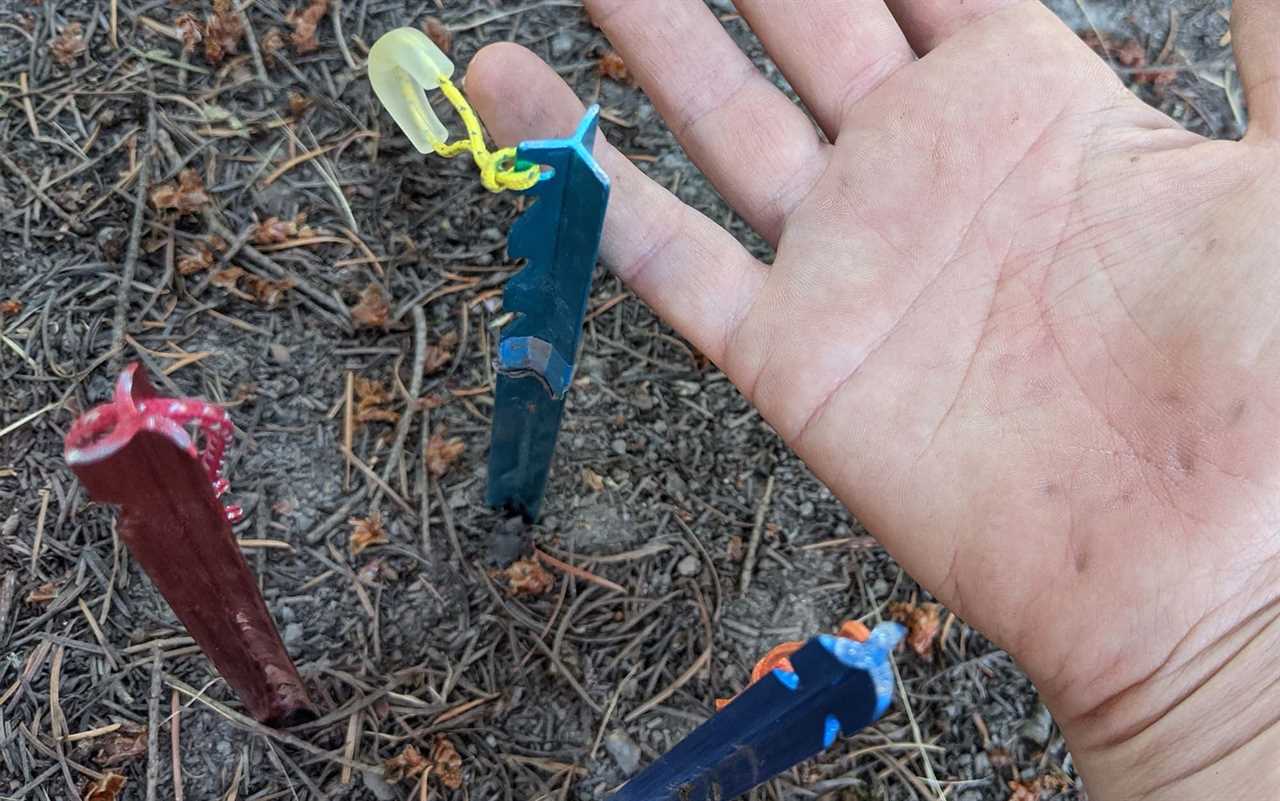
Y-shaped tent stakes have excellent staying power, but are pretty uncomfortable to press into the ground with your hand. Laura Lancaster
The final stake type is a V-shaped design. During testing, this had slightly less holding power than the Y-shaped design, but significantly more holding power than the cylindrical design.
Material
The stakes in my test were primarily made from four different materials: steel, carbon fiber, aluminum, and titanium. Steel is strong, inexpensive, and heavy. My best tent stake for car camping pick is made from steel, but you wouldn’t want to carry it on a 20-mile backpacking trip. On the opposite end of the spectrum is carbon fiber, which is extremely lightweight, expensive, and strong, with one small caveat: It’s only strong in one direction. In the case of tent stakes, that strength is directed at managing impacts coming at the stake sideways: the up and down motion of actually getting the stake into the ground can cause problems.
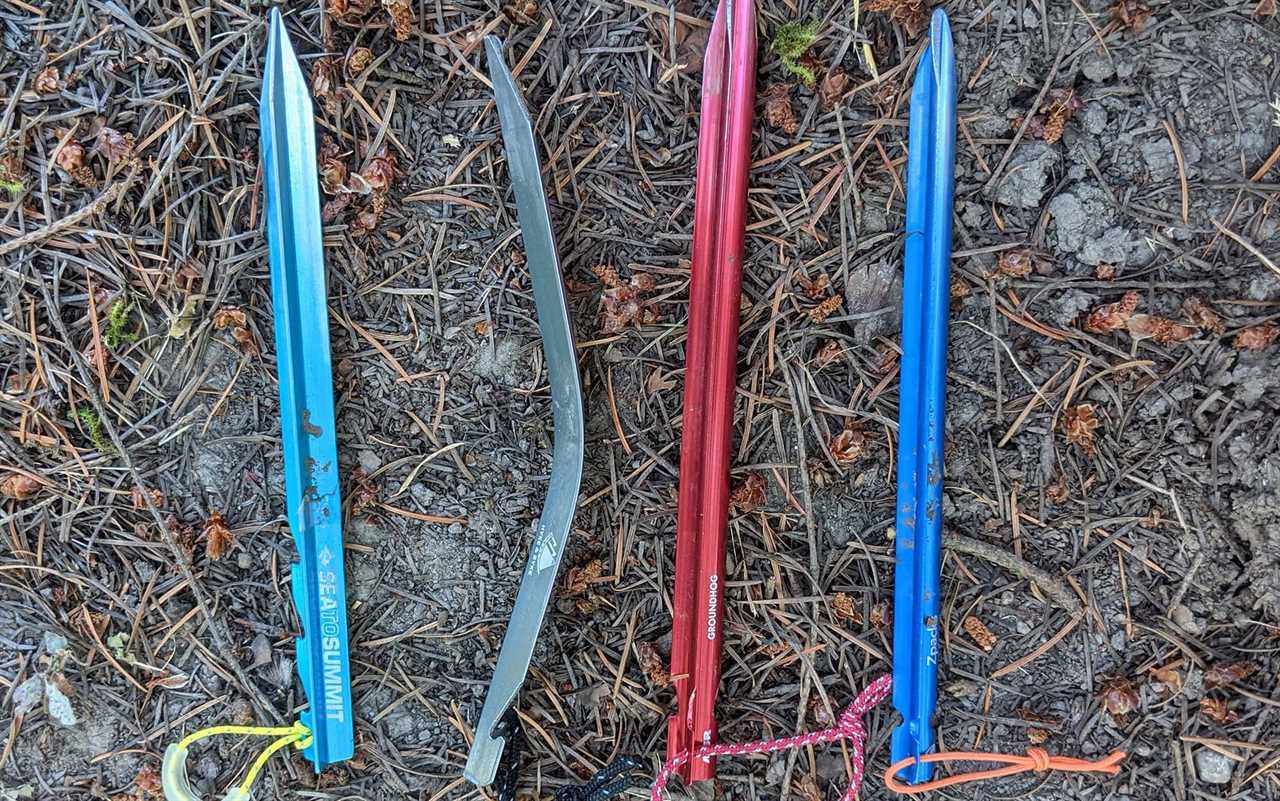
(Left to right) The Sea to Summit Ground Control, Hyke & Byke, MSR Groundhog, and Zpacks Super Sonic are all made from aluminum, but they did not all survive the boot test Laura Lancaster
Titanium, which is strong (in all directions), lightweight, and expensive has become something of a gold standard for lightweight gear. But during testing, I found that with the exception of the lightest weight stakes, that aluminum actually performed better than titanium (something that was notably not the case in our test of the best camping utensils). This is not to say that backpackers should replace all their titanium gear with aluminum—not all aluminum stakes performed the same in my test (reflecting the quality of aluminum being used), and once bent, aluminum was difficult to return to its original position.
Length
Longer stakes are heavier, while shorter stakes provide less holding power. Consider which is most important to you when choosing a stake, and try not to go shorter than six inches.
Weight
Half an ounce give or take may seem insignificant to all but the most dedicated gram counters, but when you need to carry six, eight, ten of an item, it starts to add up. Sticking with aluminum or titanium stakes is a smart choice for most backpackers looking to save weight without sacrificing performance.
FAQs
Q: How much do tent stakes cost?
Tent stakes typically cost between $3 and $5 with the most expensive stake we looked at going up to $10.
Q: What is the best way to stake a tent in the snow?
While you can purchase dedicated snow stakes, you can also create a so-called deadman anchor by piling up snow on top of whatever you have attached your tent cord or guyline to; in this instance, it doesn’t even need to be a stake, although these work well for this purpose.
Q: What tent stakes are good for sand?
If you are planning to backpack along the beach, the Big Agnes Dirt Daggers are an excellent choice, as they’ll cut through the loose top layer down to the more compacted sand below. However, if you plan to camp on a sand dune, which is nothing but loose sand, consider swapping out your stakes for something else entirely: a sand bag, which essentially functions as a deadman anchor for sandy terrain.
Final Thoughts
The MSR Groundhog, Zpacks Super Sonic, and Sea to Summit Ground Control are all some of the best tent stakes available, and performed at a similarly high level during testing. While I ranked the MSR Groundhog in the top slot, If you rank features and low weight over performance, go with the Sea to Summit Ground. If price is your top concern, choose the Zpacks Super Sonic. Ultralight enthusiasts will find that the MSR Carbon Core maximizes strength for weight (but still plan to treat this more delicately than you would our top picks), while car campers will get all the performance they need out of the moderately priced Decathlon Quechua Hard Ground. If you are heading into challenging terrain and need a stake that can hold in everything from hard ground to loose sand, then the Big Agnes Dirt Dagger UL is the right tent stake for you.
The post The Best Tent Stakes of 2022 appeared first on Outdoor Life.
By: Laura Lancaster
Title: The Best Tent Stakes of 2022
Sourced From: www.outdoorlife.com/gear/best-tent-stakes/
Published Date: Tue, 13 Sep 2022 15:08:41 +0000
----------------------------------------------
Did you miss our previous article...
https://manstuffnews.com/weekend-warriors/search-for-three-missing-moose-hunters-in-alaska-still-ongoing-another-moose-hunter-found-deceased
 Backyard GrillingWeekend WarriorsAdvice from DadBeard GroomingTV Shows for Guys4x4 Off-Road CarsMens FashionSports NewsAncient Archeology World NewsPrivacy PolicyTerms And Conditions
Backyard GrillingWeekend WarriorsAdvice from DadBeard GroomingTV Shows for Guys4x4 Off-Road CarsMens FashionSports NewsAncient Archeology World NewsPrivacy PolicyTerms And Conditions
